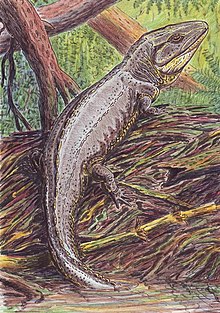Proterogyrinus
| Proterogyrinus | |
|---|---|

| |
| Skull diagram | |
| Scientific classification | |
| Domain: | Eukaryota |
| Kingdom: | Animalia |
| Phylum: | Chordata |
| Clade: | Sarcopterygii |
| Clade: | Tetrapodomorpha |
| Order: | †Embolomeri |
| Family: | †Proterogyrinidae |
| Genus: | †Proterogyrinus Romer, 1970 |
| Type species | |
| †Proterogyrinus scheelei Romer, 1970
| |
| Other species | |
| |
| Synonyms | |
| |

Proterogyrinusis an extinctgenusof earlytetrapodsfrom the orderEmbolomeri.Fossil remains ofProterogyrinushave been found in Scotland, UK, andWest Virginia,United States, and date back to theSerpukhovian(mid-Carboniferousperiod), which is from about 331 to 323 million years ago.[1]The genus was originally named by renowned vertebrate paleontologistAlfred Sherwood Romerin 1970.[2]A comprehensive redescription was later published by Canadian paleontologist Robert Holmes in 1984.[3]The generic name "Proterogyrinus"isGreekfor "earlier wanderer" or "earliertadpole".This name was chosen by Romer in keeping with a trend of naming long-bodied early tetrapods (such asEogyrinusandCrassigyrinus) with the suffix "-gyrinus".[2]
Romer hesitated from designatingProterogyrinusas a true embolomere, because its intercentra (the forward portion of each vertebra) were smaller than its pleurocentra (the rear portion). He used the groupAnthracosauriato encompass embolomeres and their close relatives such asProterogyrinus.[2]However, other sources prefer a wider definition of Embolomeri similar in usage to Romer's Anthracosauria, thus countingProterogyrinusas an embolomere.[3]
Description
[edit]In most respectsProterogyrinusresembled other embolomeres such asArcheria,with a moderately elongated skull that was taller than that of other early tetrapods such ascolosteidsandtemnospondyls.Members of the genus had strong limbs with several fully-ossifiedankle and wrist bones. This would have givenProterogyrinusthe ability to walk and hunt on land. However, the presence oflateral line groovesandotic notcheswhich likely heldspiraclesshow that they were probably more well-adapted for the water. The tail was long and tall, and was likely a powerful method of locomotion. The eyes were positioned high on the skull, supporting the idea thatProterogyrinushad an active lifestyle near the surface of the water.[3]
References
[edit]- ^Haines, Tim; Paul Chambers (2006).The Complete Guide to Prehistoric Life.Canada: Firefly Books. p.38.
- ^abcRomer, A.S. (30 April 1970)."A new anthracosaurian labyrinthodont,Proterogyrinus scheelei,from the Lower Carboniferous ".Kirtlandia.10:1–16.
- ^abcHolmes, R. (2 November 1984). "The Carboniferous AmphibianProterogyrinus scheeleiRomer, and the Early Evolution of Tetrapods ".Philosophical Transactions of the Royal Society of London. Series B, Biological Sciences.306(1130): 431–524.doi:10.1098/rstb.1984.0103.






